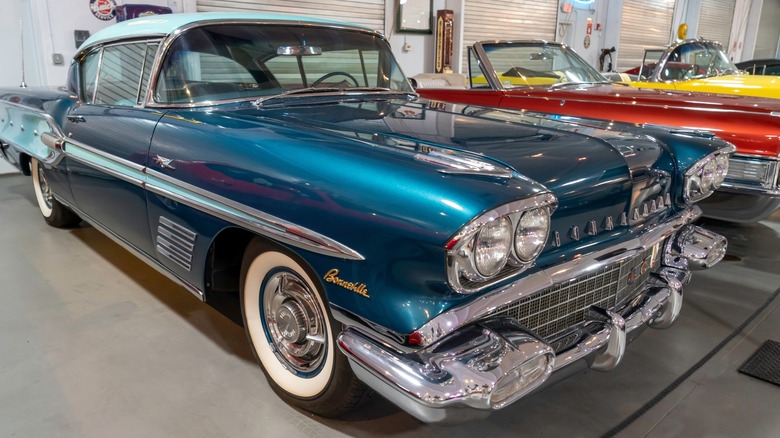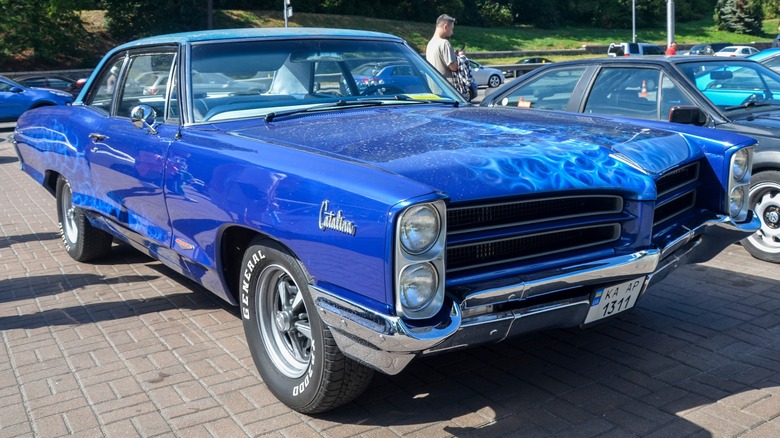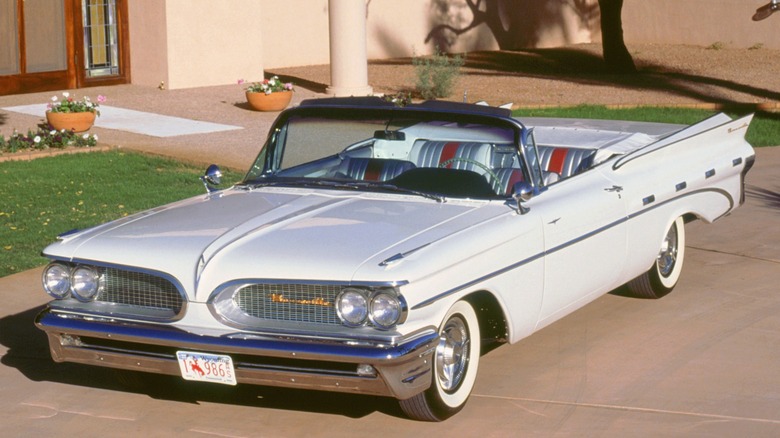Pontiac Catalina Vs. Bonneville – The Biggest Differences Explained
Pontiac had a reputation for producing some of the most recognizable muscle cars of the era with its various GTO and Firebird models. However, that sporty legacy began with some of Pontiac's most underappreciated muscle cars rooted in the 1950s. The 1965 Pontiac Catalina 2+2 was among them, and while it shared Pontiac's most potent powertrains — along with the Bonneville — they were rarely, if ever, viewed as sports cars. On the other hand, the Pontiac GTO, largely credited with starting the muscle car movement, was introduced in 1966.
Maybe it was the GTO's timing, or maybe the larger and more upscale Pontiacs fell under the curse of trying to sell an old person's car to a young person that Semon "Bunkie" Knudsen tried to avoid after being named Pontiac's general manager in 1956. While the Pontiac Catalina and Bonneville models maybe weren't destined for muscle car fame, they were comfortable cars with a sporting heritage, and some of the longest running models in Pontiac's history.
The Bonneville name first appeared as a trim level on Pontiac Star Chief Convertibles before its 1958 debut as a stand-alone model at the top of Pontiac's lineup. The Catalina went from being a body style designation on other Pontiac models to a model of its own a year later in 1959, positioned as a more entry-level full-size Pontiac. Both models continued on Pontiac's roster for many years, with the automaker finally dropping the fifth-generation Catalina in 1981, and the tenth-generation Bonneville in 2005.
The entry-level Pontiac Catalina
The first-generation Pontiac Catalina (1959-1960) rolled out of the factory on the new "Wide Track" frame and a 121-inch wheelbase, with multiple body styles from coupe, sedan, convertible, and station wagon. Its modest feature set included interior dome lighting, electric windshield wipers, a cigarette lighter, and ashtrays for front and rear seat passengers. The Pontiac 389 cubic-inch V8 was the standard power plant, configured with power ratings from 215 to 345 horsepower, depending on options and drivetrain ordered.
Second-gen Pontiac Catalinas (1961-1964) saw a shorter, 119-inch wheelbase, and about a 1.5-inch reduction in its "Wide Track" stance. Pontiac also introduced an additional engine option for the Catalina in 1961 — a 421 cubic-inch "Super Duty" V8 with a 405-horsepower rating. Pontiac launched the third-gen Catalina in 1965, keeping the two V8 engine options with various power outputs depending on configuration, and adding other V8 options throughout the generation. The Catalina's wheelbase extended to 121-inches, and the rear track pushed out to the original 64-inch "Wide Track" dimension.
Pontiac Catalinas produced from 1971-1976 fall under the fourth-generation and feature a longer 123.5-inch wheelbase. The Catalina's engine options had settled to three offerings by 1971; including 350, 400, and 455 cubic-inch V8 options producing up to 300 net horsepower. The fifth and final generation of Pontiac Catalina included model years ranging from 1977-1981. The 1977 Catalina featured a shortened 115.9-inch wheelbase, and also offered a range of six and eight-cylinder engines.
The Pontiac Bonneville, an upscale full-size model
The Bonneville was among the largest models Pontiac ever made, enjoying a production run spanning 48 model years and 10 generations from 1958 to 2005. Its first three generations occurred over seven model years, with the first generation lasting a single year. The first four generations of Pontiac Bonneville are often highly regarded, mostly due to their rarity and muscular engine options. While the first-gen body style had that classic 1950's GM look, subsequent iterations saw the evolution of Pontiac's signature protruding nose and split grille.
Engine options evolved over the years following a similar trajectory as other full-size Pontiacs. The Bonneville's size varied as well, including a short stint as a midsize model for the seventh-generation, but was typically the largest of Pontiac's offerings. While the first Pontiac to wear the Bonneville badge did so to denote a special trim level for the Star Chief Convertible, the model would see a variety of body styles. A range of coupes, sedans, convertibles, and station wagons ensured there was a Pontiac Bonneville to fit the needs of nearly every consumer.
Compared to the Catalina, the Pontiac Bonneville was always a step ahead, beginning with its introduction occurring a year earlier. The Pontiac Bonneville was always just a little bigger and more luxurious than the Catalina, all likely reasons the Bonneville nameplate carried on much longer.


